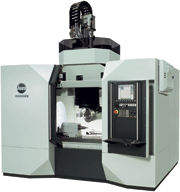E-Archive
Good Vibrations
in Vol. 11 - September Issue - Year 2010
The Kneed For Surface Finishing

Artificial knee joints

Machining centre

Drag machine
The increasing number of knee replacements (arthroplasty) can be attributed to different reasons, we are generally living longer, more people participate in prolonged high impact sports leading to increased wear and tear, and other reasons could be due to an injury or degenerative disease such as osteoarthritis. Modern surgical techniques and implant advancements have made the replacement procedure available to many people improving their quality of life and helping the individual to return to pain free mobility, recent demographics indicate that in excess of one million knee joints are replaced worldwide every year, with this number set to increase by 10 – 15% year on year manufacturers are constantly striving to improve the quality and performance of the implant and reduce production costs. The artificial knee is consists of 3 components; the knee joint that fits around the lower part of the thigh bone (femur) and the stem/plate that is implanted into the tibia bone, these components are normally made of cobalt-chrome or titanium, an interfacing high performance polyethylene insert is clipped to the tibia tray completing the assembly. Efforts to perfect the artificial knee implant are consistently taking place. One important area that affects both performance and the functional life is the surface finish of the contact points. The challenge today has been to develop equipment and processes that can keep up with the increasing demands from the industry for controlled, uniform and repeatable super finishing of the very complex shape of an artificial knee joint. At the same time the quantities are increasing and manufacturing and finishing costs must be considered. The vibratory mass finishing technique has had some success super polishing mass produced knee joints however it is fair to say that the desired finish was not always obtained or had some practical limitations. That was until recently when the market leader in surface finishing joined forces with a leading manufacturer of machining/grinding centre. The coming together of these companies has meant that they each now understand one another’s technology and capabilities, a joint R&D team have now been able to refine both the machining/grinding and super finishing processes resulting in surface finishes that were previously not possible to achieve. The two partners cooperate with the customer early in the project stage exchanging their technical ideas and knowhow but moreover listening to the customer’s preferences. By doing this the customer is assured of the optimum process technology from raw material to finished product. For creating the complex shape of a knee joint machining centres are used that are now available with an integrated belt grinding system. This feature allows the simultaneous processing of two implants. After clamping the component alignment and removal of the gates and risers, the functional surfaces of the condyle and patella are ground. Subsequently, the outer contours and (depending on the type of knee) the "box" area is milled. In a further automatic operation the transitional surface areas are leveled without having to re-clamp the component, at this point the grinding belt is controlled by the same geometrical data as the grinding wheel on the machining centre. The fact that the complete grinding process takes place by clamping the component only once saves time and also contributes to a significantly improved quality. After geometric grinding the implants show readings of Ra = 0.40 µm – Ra = 0.20 µm on all functional surface areas. The time required for the geometric grinding process varies is between 12 and 30 minutes for two components (depending on the complexity of the knee joint). Typically the surface of a knee joint as it comes off the grinding machine and before super finishing can be Ra =0.8 µm up to Ra = 1.0 µm. In this instance the knee manufacturer has decided on a relatively short machining/grinding sequence meaning that a 3 stage super finishing process will be required, in some cases this may vary, for example more operations and longer on the machining centre would require a 2 stage process in the surface finishing machine. This is a good example of how the cooperation between the surface finishing company and the machining supplier allows the customer to decide which option is commercially and or practically best for him. Super finishing takes place in a special compact drag finishing machine processing up to 28 knee joints in one batch, the knee joints are individually positioned on a fixture ensuring no part on part contact. Once the components have been mounted on the fixture the implants are immersed into a bowl filled with a special media and "dragged" through the mass in a circular motion, the rotating systems are powered by two independently controlled drive motors. The metal removal takes place evenly around the complete surface of the knee and leaves no secondary burrs whatsoever. This is an additional benefit as the precision edge-breaking (radiusing) of the outer contours of the femur facilitates its subsequent attachment to the human tissue. The second step of the 3 stage process uses an ultra fine plastic bonded media that blends the surfaces uniformly. The final stage of the super finishing process is dry using an organic dry polishing media that produces a surface reading of Ra = 0.02 µm -0.03 µm with a very high gloss finish perfect for antifriction and long trouble free service. The drag finishing technique is also used successfully for finishing other types of implants such as hip joints, shoulder implants, bone plates etc, as well as other very complex shapes such as aero-engine components.
Another benefit, especially for the manufacturers of high volume knee joints, is the consideration of the various interface options between the steps of geometric machining/grinding, component transfer and the surface finishing process.
Good Vibrations
by Paul Rawlinson
Contributing Editor MFN & Business Development Manager, Aerospace International for Rösler
Tel. +49.9533.924 647
Fax +49.9533.924 601
E-mail: P.Rawlinson@rosler.com




























